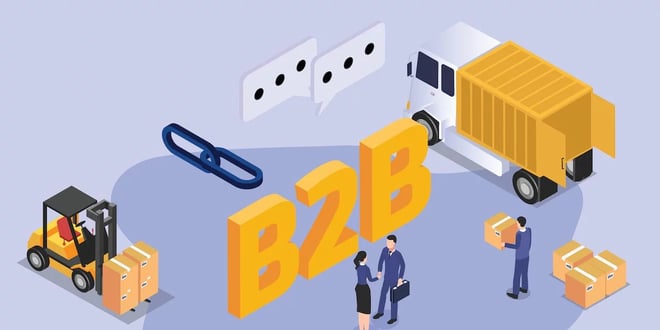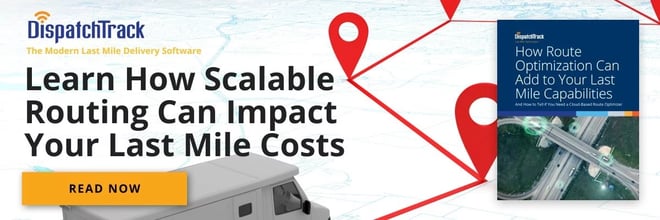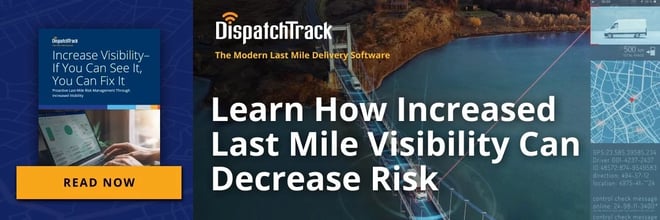B2B buyers and consumers increasingly share some similarities—for instance, modern B2B buyers are quick to demand the same delivery experience end customers enjoy. Buyers who are used to getting frequent alerts, real-time visibility, and accurate ETAs for their delivery orders in their personal lives now want the same experience when procuring for their jobs. The result? New and complex challenges for B2B delivery companies.

Shippers are handling much bigger purchase orders when dealing with B2B companies. They also often have to consistently deliver large quantities over a long period because of their contracts with customers. Failing to handle deliveries properly can damage the long standing business relationships that are key to continued success.
B2B Last Mile Optimization Challenges
In many ways, B2B and B2C delivery operations share overlapping challenges—and yet, many commonly available tools and techniques really only apply to one or the other.
Here are are some of the top B2B last mile delivery optimization challenges:
Reducing Delivery Times
The logistics industry has been dealing with the Amazon effect for some years now as more consumers place higher importance on speed of delivery rather than the product of price points. In a B2C environment, shippers have an incentive to optimize their last mile operations as many shoppers are willing to pay for faster shipping.
In the B2B world, offering faster deliveries will help companies achieve a significant competitive advantage. Using a local warehouse in highly dense areas to get products closer to end customers is one strategy heavily employed these days. Having smaller delivery hubs in strategic locations goes a long way in both improving delivery efficiency and reducing last mile delivery times.
Many B2B sellers have also adjusted their strategies and are decreasing their order sizes to balance out the additional overhead cost of maintaining more warehouses. Investments in strategically located warehouses can pay dividends here. Consumers and local businesses located in rural areas are used to getting their packages using next-day or same-day deliveries. As such, B2B companies must deliver anywhere at great speed to ensure their competitiveness.
At the same time, many B2B operations rely on recurring customers, who tend to want regular deliveries at set times. You can’t just move those delivery windows up because you’re ahead of schedule—which means that you need a way to quickly and easily slot new stops in between your recurring orders.

Providing Great Delivery Experiences—Even in a Pandemic
Like we alluded to above, the emergence of sophisticated new technologies in recent years has also pushed customers to change their expectations. Customer expectations remain high despite the disruptions being experienced in economies and supply chains around the world brought on by COVID-19. Both B2C and B2B customers still expect fast deliveries. In fact, they’re often more reliant on them than ever, since their own flexibility in procurement may be decreasing. More than that, your customers may be dealing with significant volatility in demand—meaning there’s a greater chance than ever of last minute order changes.
Essentially, this volatility gets passed on to the delivery organization, which has to find a way to handle fluctuating order volumes and changing customer needs without losing efficiency. Meanwhile, both B2C and B2B customers continue to demand transparency and visibility in the delivery process, which is on top of fast delivery times. Customers don't expect businesses to compromise when it comes to transparency and visibility, expected time of arrivals, or the delivery process just because of volatility. B2B sellers have an opportunity to capitalize on these changing needs—provided they have the right tools to manage unpredictable volume fluctuations.

Outdated Delivery Business Models
Again, grappling with volatility is of paramount importance. To this end, it’s important to stay as agile as possible, which means: rerouting deliveries on the fly, accommodating changes quickly, and utilizing capacity in a flexible way. Here, B2B operations heavily reliant on the old delivery business models (i.e. only relying on their own fleets and drivers) are having a hard time keeping their delivery costs low and ensuring operational efficiency in their delivery services.
Working with 3PLs or simply working with contract drivers rather than relying on in-house fleets allows B2B companies to be more flexible in terms of fleet size. Contracting outside drivers allows businesses to scale down or up their fleets easily to adjust to current demand levels. Hybrid fleet models are also on the rise, allowing enterprises to maintain their own fleets and outsource to third-party partners at the same time.
The trick here is ensuring that your last mile tracking and optimization technology is up to the task of accommodating the needs of outside stakeholders. If your delivery data lives in silos and your drivers are being dispatched manually, scaling can be a near impossibility. On the other hand, if you’re relying on scalable, flexible, cloud-based last mile technology, you might be in a position to easily share information with your partners—and thereby boost your efficiency across the board.
Outdated Last Mile Delivery Technology
The kind of technology integration we described above simply isn’t possible with outdated technology. Legacy systems and manual processes significantly affect productivity and profitability. Unfortunately, a huge percentage of transportation and logistics companies admit to still using outdated technology.
In a recent SOTI report, more than half of transportation and logistics companies surveyed were convinced that their continued use of outdated technology either has caused or is causing them to lose their customers. Without modern technology, B2B companies are ill-equipped to adjust to unexpected situations, handle last mile delivery operations efficiently or remain competitive.
At the end of the day, outdated technology, business models, and business practices limit what a B2B company can do. Sticking to the familiar won't help enterprises adapt to the current business environment. The above challenges facing B2B companies emphasize the need for a review of current strategies and business models. Investing in new technologies and solutions can help B2B firms increase operational efficiency, ensure business continuity, and minimize the impact of the unexpected such as the COVID-19 pandemic. In the end, adopting new solutions and business innovations is the best way for B2Bs to move forward in a more competitive landscape.